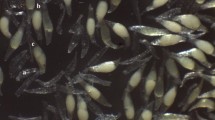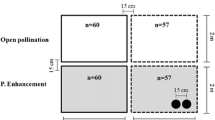Abstract
A 2-year study of three natural populations of the distylousJasminum fruticans showed that mean fruit and seed production were significantly greater in shortstyled plants (thrums) than in long-styled plants (pins). In this study, we investigated the role of four sequential factors which may differentially influence fruit and seed set in the two floral morphs: (1) differences in flowering phenology, (2) a limitation of pollen transfer towards pins, (3) a differential capacity of the two morphs to act through famale and male function and (4) differential fruit abortion in the two morphs. Fruit set was significantly influenced by differences in flowering phenology although there were no differences in flowering time between the two morphs. supplementary pollinations in a natural population significantly increased fruit set and reduced the difference in fruit set between the two morphs in relation to controls, indicating a limitation on pollen transfer which was most severe towards pin stigmas. In reciprocal crosses, seed set was significantly dependent on the paternal and maternal identity of the pin parent. There was no significant variation among thrums for their performance as male or female parent. Furthermore, individual pin plants with relatively high percentage seed set as female parents gave poor seed set as male parents and vice-versa. Whereas fruit removal had no effect on seed number in thrum plants, a greater proportion of viable seeds were produced on pin plants which were left to naturally mature their fruits than on pins which had fruits artificially removed, suggesting the occurrence of selective fruit abortion in pins but not in thrums. The initially greater maternal fitness of thrums due to their greater success as pollen recipients may thus be opposed by increased viable seed set in the pins due to factors acting after the pollination stage. The relative reproductive success of floral morphs in the distylousJ. fruticans is thus differentially influenced by ecological factors occurring at different stages of the reproductive process.
Similar content being viewed by others
References
Barrett SCH (1990) The evolution and adaptive significance of heterostyly. Trends Ecol Evol 5: 144–148
Barrett SCH, Shore JS (1987) Variation and evolution of breeding systems in theTurnera ulmifolia L. complex (Turneraceae). Evolution 41: 340–354
Bawa K (1980) Evolution of dioecy in flowering plants. Annu Rev Ecol Syst 11: 15–39
Bawa KS, Webb CJ (1984) Flower, fruit and seed abortion in tropical forest trees: implications for the evolution of maternal and paternal reproductive patterns. Am J Bot 71: 736–751
Beach JH, Bawa KS (1980) Role of pollinators in the evolution of dioecy from distyly. Evolution 34: 467–474
Bertin RI (1982) paternity and fruit production in trumpet creeper (Campsis radicans). Am Nat 119: 694–709
Campbell DR (1991) Effects of floral traits on sequential components of fitness inIpomopsis aggregata. Am Nat 137: 713–737
Casper BB (1988) Evidence for selective abortion inCryptantha flava. Am Nat 132: 318–326
Charlesworth D (1989) Evolution of low female fertility in plants: pollen limitation, resource allocation and genetic load. Trends Ecol Evol 4: 289–292
Charnov R (1982) The theory of sex allocation. Princeton University Press, Princeton, New Jersey
Crawley MJ (1983) Herbivory. The dynamics of animal-plant interactions. Blackwell Scientific Publications, Oxford
Darwin C (1877) The different forms of flowers on plants of the same species. John Murray, London
Devlin B, Ellestrand NC (1990) Male and female fertility variation in wild radish, a hermaphrodite. Am Nat 136: 87–107
Dieringer G (1991) Variation in individual flowering time and reproductive success ofAgalinis strictifolia (Scrophulariceae). Am J Bot 78: 497–503
Dommée B, Thompson JD, Cristini F (1992) Distylie chezJasminum fruticans L.: hypothèse de la pollinisation optimale basée sur les variations de l'écologie intraflorale. Bull Soc Bot France, 139: 223–234
Dulberger R (1970) Floral dimorphism inAnchusa hybrida Ten. Isr J Bot 19: 37–41
Escarré J, Thompson JD (1991) The effects of successional habitat variation and time of flowering on seed production inRumex acetosella. J Ecol 79: 1099–1112
Ganders FR (1979) The biology of heterostyly. NZ J Bot 17: 607–635
Hossaert M, Valero M (1988) Effect of ovule position in the pod on patterns of seed formation in two species ofLathyrus (Leguminosae: Papilionoideae). Am J Bot 75: 1714–1731
Kohn JR, Barrett SCH (1992) Experimental studies on the functional significance of heterostyly. Evolution 46: 43–55
Kwak MM, Jennersten O (1991) Bumblebee visitation and seed set inMelampyrum pratense andViscaria vulgaris: heterospecific pollen and pollen limitation. Oecologia 86: 99–104
Lloyd DG (1979) Evolution towards dioecy in heterostylous populations. Plant Syst Evol 131: 71–80
Lyons EE, Antonovics J (1991) Breeding system evolution inLeavenworthia: breeding system variation and reproductive success in natural populations ofLeavenworthia crassa (Cruciferae). Am J Bot 78: 270–287
Marshall DL (1991) Nonrandom mating in wild radish: variation in pollen donor success and effects of multiple paternity among one to six donor populations. Am J Bot 78: 1404–1418
Marshall DL, Ellstrand NC (1986) Sexual selection inRaphanus sativus: experimental data on non random fertilization, maternal choice and consequences of multiple paternity. Am Nat 127: 446–461
Marshall DL, Ellstrand NC (1988) Effective mate choice in wild radish: evidence for selective seed abortion and its mechanism. Am Nat 131: 739–756
Mazer SJ (1987) Parental effects on seed development and seed yield inRaphanus raphanistrum: implications for natural and selection selection. Evolution 41: 355–371
Muenchow GE, Grebus M (1989) The evolution of dioecy from distyly: reevaluation of the hypothesis of the loss of long-tongued pollinators. Am Nat 133: 149–156
Mulcahay DL (1974) Adaptive significance of gamete competition. In: Linskens HF (ed) Fertilization in higher plants. North Holland Publishing, Amsterdam, pp 27–30
Olesen JM (1979) Floral morphology and pollen flow in the heterostylous speciesPulmonaria obscura Duncort (Boraginaceae). New Phytol 82: 757–767
Ornduff R (1970) Incompatibility and the pollen economy ofJepsonia parry. Am J Bot 57: 1036–1041
Ornduff R (1975) Complementary roles of Halictids and syrphids in the pollination ofJepsonia heterandra (Saxifragaceae). Evolution 29: 371–373
Ornduff R (1976) The reproductive system ofAmsinckia grandiflora, a distylous species. Syst Bot 1: 57–66
Ornduff R (1979) Pollen flow in a population ofPrimula vulgaris Huds. Bot J Linn Soc 78: 1–10
Ornduff R (1980) Heterostyly, population composition, and pollen flow inHedyotis caerulea. Am J Bot 67: 95–103
Philipp M, Schou O (1981) An unusual heteromorphic incompatibility system. Distyly, self-incompatibility, pollen load and fecundity inAnchusa officinalis (Boraginaceae). New Phytol 89: 693–703
Pittman KE, Levin D (1989) Effects of parental identities and environment on components of crossing success inPhlox drummondii. Am J Bot 76: 409–418
Puech S (1986) Production de diaspores et potentialités de germination chez quelques espèces a fruits charnus, ornithochores, dans le sud-est de la France. Ecol Medit 12: 143–158
Queller DC (1983) Sexual selection in a hermaphroditic plant: Les Fleurs du Male. Nature 305: 706–708
Rameau C, Gouyon PH (1991) Resource allocation to growth, reproduction and survival inGladiolus: the cost of male function. J Evol Biol 4: 291–307
Ratheke B, Lacey EP (1985) Phenological patterns of terrestrial plants. Ann Rev Ecol Syst 16: 179–214
Rocha AJ, Stephenson AG (1991) Effects of nonrandom seed abortion on progeny performance inPhaseolus coccineus L. Evolution 45: 1198–1208
Ross M (1990) Sexual asymmetry in hermaphroditic plants. Trends Ecol Evol 5: 43–47
SAS Inst. Inc. (1990) SAS/STAT Users Guide. Version 6, 4th edn, vol. 2. Cary, North Carolina
Schemske DW (1977) Flowering phenology and seed set inClaytonia virginica (Portulacaceae). Bull Torr Bot Club 104: 254–263
Schlichting CD, Devlin B (1989) Male and female reproductive success in the hermaphroditic plantPhlox drummondii. Am Nat 133: 212–227
Schmitt J (1983) Individual flowering phenology, plant size, and reproductive success inLinanthus androsaceus a California annual. Oecologia 59: 135–140
Stanton ML, Snow AA, Handel SN (1986) Floral evolution: attractiveness to pollinators increases male fitness. Science 232: 1625–1627
Stephenson AG (1981) Fruit and flower abortion: proximate causes and ultimate functions. Ann Rev Ecol Syst 12: 253–279
Stephenson AG, Bertin RI (1983) Male competition, female choice, and sexual selection in plants. In: Real L (ed) Pollination biology. Academic Press, Orlando, pp 109–149
Sutherland S (1986) Patterns of fruit set: what controls fruit-flower ratios in plants? Evolution 40: 117–128
Sutherland S (1987) Why hermaphroditic plants produce many more flowers than fruits: experimental tests withAgave mckelveyana. Evolution 41: 750–759
Sutherland S, Delph LF (1984) On the importance of male fitness in plants: patterns of fruit set. Ecology 65: 1093–1104
Wyatt R (1983) Pollinator-plant interactions and the evolution of breeding systems. In: Real L (ed) Pollination biology. Academic Press, Orlando, pp 51–95
Zimmerman M, Pyke GH (1988) Reproduction inPolemonium: assessing the factors limiting seed set. Am Nat 131: 723–738
Author information
Authors and Affiliations
Rights and permissions
About this article
Cite this article
Thompson, J.D., Dommée, B. Sequential variation in the components of reproductive success in the distylousJasminum fruticans (Oleaceae). Oecologia 94, 480–487 (1993). https://doi.org/10.1007/BF00566962
Received:
Accepted:
Issue Date:
DOI: https://doi.org/10.1007/BF00566962




